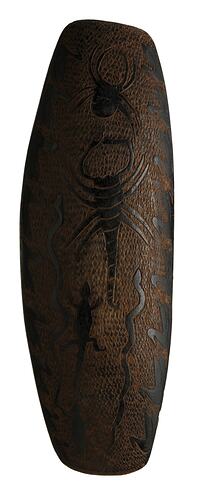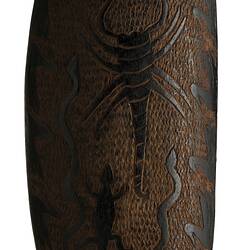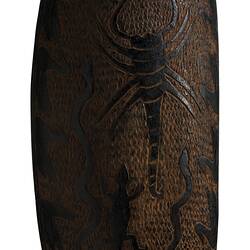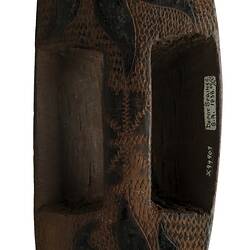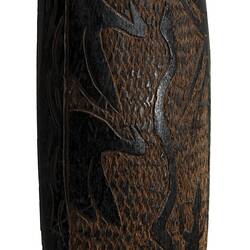Summary
During the early 1930s, artists from the Adnyamathanha community in the Flinders Ranges created beautiful and unique material culture depicting insects, lizards and birds. Regrettably the names of these highly skilled artists were not recorded, but the museum's collection of small shields, containers, boomerangs and clubs is remarkable. The engravings are painted black to contrast with the dark wood of the background, highlighting the intricate figures.
The Flinders Ranges Scorpion is one of Australia's largest species of scorpion and is unique to the country belonging to the Adnyamathanha. It is a temperate species and can be found living under rocks and logs in the moist gully areas of the ranges. The scorpion is territorial and usually solitary, building a scrape under rock to create a shallow burrow from which to hunt for their prey at night.
Aboriginal people across Australia have long used insects from their surroundings as food and medicine, and have expressed their cultural connections to them through art. Insects are also recognised as important prey for birds and lizards. Traditional ecological knowledge about insects provides the community with vital information about the availability and location of plant and animal foods and the health of the land. The detailed depiction of the scorpion on this club reveals the artist's knowledge of and connection to their country.
Physical Description
Small oval shaped shield with truncated ends. Plano-convex in cross- section. Handle flush with the surface and carved from the solid. Posterior side decorated with pokerwork design of two leaf shaped motifs. Anterior surface is decorated with a pokerwork design consisting of ducks around the edge and in the centre snakes, lizards, scorpion and spider.
Significance
Significance (Bio of artist, importance of the object, cultural/ historical significance/ significance to collection)
The lands of the Adnyamathanha people are approximately 500km north of Adelaide in the northern Flinders Ranges, in South Australia. This area includes Lyndhurst and Moolawatana Homestead in the north-west and north-east, Lake Frome in the east, and Parachilna and Blinman in the south. Atuwarapanha (Mount Serle) and Wayanha (Mount McKinlay) in the central-north of this area are important focal points for Adnyamathanha traditions and more recent history.
The Adnyamathanha traditional owners continue to live and practice their culture on their ancestral lands. In 2016 the oldest known evidence of Aboriginal settlement in arid Australia was found on the lands of the Adnyamathanha people in the Flinders Ranges, proving between 46,000 and 49,000 years of continuous occupation.
Many contemporary projects which focus on cultural maintenance and revival have been undertaken by Adnyamathanha peoples in recent times. The work of Adnyamathanha Elder Aunty Lily Neville has contributed greatly to language revival with her translations and publications in Adnyamathanha language which include songs, wordlists, observations of bush life and family stories. Her acclaimed book 'Adnyamathanha Ngawarla' includes unedited texts and hand-drawn annotated illustrations.
Adnyamathanha language has been taught in schools in and around the lands of the Adnyamathanha people for many years and in 2009 it was being learned by over 1,000 students in nine schools (five in the larger town of Port Augusta and at each school in Leigh Creek, Hawker and Quorn as well as at one school in the Adelaide area).
More Information
-
Object/Medium
Shield
-
Maker
-
Cultural Groups
-
Locality
-
Date Produced
-
Collector
-
Date Collected
-
Object Measurements
340 mm (Length), 120 mm (Width), 70 mm (Height)
-
Classification
-
Date Made
-
Maker
-
Clan/Language Group
-
Place Made
-
Indigenous Region
-
Collection Names
-
Type of item
-
Discipline
-
Category
-
Collecting Areas
